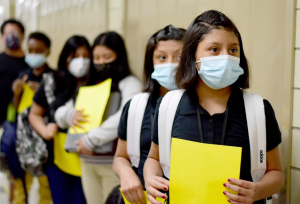Back-to-school anxiety: How to help adolescent girls cope with their COVID-era stress
The pandemic prompted the decline of classrooms, and with that, young girls’ social skills and self-confidence.
By Diane Carugati
Opinion contributor
August 27, 2021
 As adolescent girls head back to school, they may feel more than the usual jitters. Uncertainty and change await them after spending months in the safety of their homes, and that might cause added anxiety.
As adolescent girls head back to school, they may feel more than the usual jitters. Uncertainty and change await them after spending months in the safety of their homes, and that might cause added anxiety.
The COVID-19 pandemic has drastically changed the way kids receive an education. During the last academic year, more than 90% of American homes doubled as classrooms, according to the U.S. Census Bureau. With the pandemic in a constant state of flux, school districts did their best to adjust on the fly, and students found themselves learning at home, in classrooms or in hybrid of the two.
But the necessity of distance learning took a toll on many adolescent girls, particularly those from low-income households who did not have consistent access to the internet or a computer. A staggering number of students didn’t have adequate resources, teachers trained in remote learning techniques or access to the meals they would normally get at school, and this caused them to fall behind or miss their remote classes altogether.
We lost social skills while in isolation
While distance learning was necessary for student safety, it had an unintended negative effect on the mental health of adolescents across the country. More and more young people were in crisis, with the Centers for Disease Control and Prevention reporting a 31% increase in mental health-related emergency department visits among adolescents ages 12 to 17 in the months following lockdown mitigations compared with the same time the previous year.
A recent study found a rise in anxiety and panic disorders among adolescent girls because of their experiences during the pandemic. Among the factors that contributed to the symptoms they suffered from, fears about school were at the top of the list.
Not only were they afraid of getting sick, but they were also worried about balancing distance learning with their home lives, passing their classes and having quality remote learning options.
Although educators and parents made the most of these challenges, adolescent girls were left without a safe space to just be kids. In the absence of a deadly virus, this time in a young girl’s life is typically full of positive change and development. Adolescence is a crucial time in which girls start to explore their identities and ask themselves: Who am I? What do I believe? What do I want out of life?
Those are tough questions to explore when your world has been shaken by isolation and instability, and chances to socialize are limited to the people in your household.
Throughout the pandemic, interactions like checking in with friends at lockers between classes and celebrating milestone events like prom were reduced to drive-by greetings, messaging on social media and chatting through screens. As a result, vital social skills started to rust.
Back to school, but not to normal
Now, adolescent girls are stepping back into the classroom, some for the first time since schools initially shut down. And this time, they’re asking themselves a new set of questions: Is it safe? Will talking to my friends in person feel like it did before? How will I feel about being around so many people? Can I bring my grades back up after so long? What does “normal” look like now?
To add to these concerns, the classroom likely won’t look the same. Masks might be required, and there may be daily temperature checks, hand-washing guidelines and social distancing measures.
If school had once been a positive place, that may no longer be the case. After the reprieve of summer break without the worries of classes, classmates or school safety concerns, walking through those classroom doors might seem daunting.
The mild nervousness or anxiety adolescent girls may feel at the end of summer has been heightened for some. And it’s no wonder: At home, kids have a more controlled environment to manage whom they talk to, when they interact with people and what they do.
In the face of these many potential challenges, how can parents help? Here are a few tips:
►Talk to your daughter. Most important, listen to her responses. Her willingness or hesitancy to discuss what she has been experiencing at school can inform your next steps.
►Offer support and stability. With so many changes occurring in your daughter’s life, knowing that home is a safe and supportive place can make a world of difference.
►Trust your instincts. When it comes to your daughter, you are an expert. If you notice a significant change in her mood, habits or behaviors, don’t ignore these warning signs.
►Contact the school. Share your observations with your daughter’s teacher or guidance counselor. Request that they keep you updated on her progress and any behavioral concerns that arise.
►Get professional help. If your daughter’s struggles persist, contact your family doctor or another qualified health care provider. They can assess your daughter’s mental health and help you decide whether treatment is the right next step.
Teachers, coaches and other adult mentors also have a vital role to play in supporting adolescent girls. Here are four valuable steps they can take:
►Give students time and space when they need it. Let them step out of the classroom or remove themselves from an activity to gather their thoughts when necessary.
►Establish a predictable schedule and be sure to incorporate extra breaks.
►Provide students with access to hand sanitizer and similar supplies. This can help them feel safer in their personal space.
►Contact parents about worrisome behaviors.
When all concerned adults remain vigilant, communicate with each other, and work in active collaboration to identify problems and develop solutions, this creates a healthy environment where girls are empowered to succeed.
Getting back to in-person learning is certainly important for adolescent development and growth. But it doesn’t have to be fear inducing.
Some adolescent girls may just need some extra care and warmth as summer ends and they adjust to a new school year. Others may need more structured assistance.
What’s most important is ensuring that every adolescent girl receives the right type and level of support so that she can achieve to her greatest potential.
Link to article: https://www.usatoday.com/story/opinion/2021/08/27/help-girls-school-anxiety-amid-covid/8254363002/






